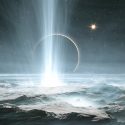A giant asteroid is headed our way. But no, it won’t hit the Earth. This asteroid is about to slam into the Moon and crack it right in half. What would it be like to witness this epic collision? Would the Moon break clean in two? Or would it shatter into a million pieces? And how could one of these pieces wipe out life here on Earth?
Before getting into our scenario, let me tell you about the time long ago when the Moon almost exploded. It was a beautiful summer night in England in the year 1178. And one hour after sunset, people witnessed a spectacular phenomenon. A giant flame appeared around the upper part of that evening’s crescent Moon. And right before their eyes, the Moon appeared to split into two before turning black.
At least this is how the event was recorded by the local chronicler. As you could probably guess, the Moon didn’t actually split in half that night. It’s possible that what those people saw was a large asteroid slamming into it. But an event like this would have sent massive amounts of lunar material toward Earth.
More likely, what they witnessed was a meteorite entering the atmosphere and crossing their line of sight directly in front of the Moon. This would have given the illusion of it splitting into two in a fiery fashion. But who needs illusions or questionable historical accounts when we could imagine what would really happen. Just get ready to avoid falling Moon rocks.
The Moon is bombarded by hundreds of asteroids and meteorites every year. And without an atmosphere like we enjoy back on Earth, these objects don’t burn up before impact. So even a meteorite as small as 25 cm (10 in) across could have a big impact on the Moon. In 2006, one approximately this size slammed into it.
From Earth, the impact looked like a flash that lasted only four-tenths of a second. But it created a crater about 14 m (46 ft) long and 3 m (10 ft) deep. Taking things up a notch, a 40 cm (16 in) meteoroid slammed into the Moon at a speed of 90,100 km/h (56,000 mph). This was such an intense collision that it caused a flash as bright as some stars in the night sky.
That means when this happened in 2013, you could look up and see the events unfolding without a telescope. For one whole second, at least. The likeliest contender within our Solar System of doing some serious damage to the Moon would be Ceres. It’s the largest object found in the belt between Jupiter and Mars. While it is technically classified as a dwarf planet, it’s still only about a quarter as large as the Moon.
But even that wouldn’t be enough to break the Moon in two, or at least to knock it out of its orbit. For that, you’d need an asteroid almost the same size as the Moon itself. And if this happened, you’d know it right away. About 1.3 seconds after impact, you’d see the Moon being torn apart. Massive amounts of debris would be hurtling toward Earth.
Some of this debris could be even larger than the asteroid that caused the mass extinction of the dinosaurs. But before you start picturing the life-on-Earth-wiped-out scenario, things might not be as bad as you think. Normally, Earth-bound asteroids travel at speeds faster than 100 km/s (62 mi/s). But it would be different for the chunks of the broken Moon and the Moon-destroying asteroid.
These would have much lower speeds. And with that, much less energetic impacts. If you were lucky, the impact from even the most colossal pieces of lunar debris would release only 1% of the energy of a similarly-sized asteroid. Adding to your luck, you’d get to witness a meteor shower of truly epic proportions as smaller bits of debris would burn up in the atmosphere.
And this epic collision wouldn’t result in two split halves of the Moon now orbiting around Earth. Sadly, you’d have to kiss the Moon goodbye. It would be shattered into a million pieces.
But if it were to somehow break, more or less, in two, there would be a chance you wouldn’t even know. At least not right away.
That’s because the asteroid could have split the Moon right between the side that always faces Earth and its dark side. You could still see the front of the Moon beaming down on you. Eventually, the two halves could escape each other’s gravity, revealing two hemispheres in the night sky. And they’d stay that shape for a long time, until the effects of gravity pulling each half from all sides turns them both back into smaller spheres.
But this would take many millions, if not billions of years. And you’d have to keep your fingers crossed that these two moons wouldn’t crash into each other at some point. Or maybe you’d hope they would at this point, just to keep the fiery spectacles going. If the Moon is blown to bits, our night sky would be permanently transformed into a dazzling sea of stars.
Venus would become the new, brightest object despite the fact that it’s 14,000 times less bright than the Moon once was. Some of the more drastic consequences of the Moon being destroyed would start to make your life difficult. The Moon is responsible for Earth’s 23.4-degree tilt on its axis. Without it, this tilt could become as much as 45 degrees.
That would make the planet spin nearly on its side. This would mean the Sun would no longer shine directly over the equator. Instead, it would beam down closer to the North and South Poles. This would trigger some extreme weather and could lead to ice ages that occur on different parts of the planet as often as every few thousand years. And the tides would never be the same again.
Earth’s powerful tides are caused by the Moon’s gravitational pull on our oceans. The Sun’s gravitational pull on our sea levels is only about half of what the Moon can pull off. No longer having the Moon in our orbit would lower sea levels and have a huge effect on ecosystems in intertidal zones.
Wild animals would now have even more fierce competition for food and shelter. And this could really endanger a lot of marine life, like sea turtles. The rising and falling of tides is an extremely important factor in giving their offspring the best chance of survival. Still, this would all be a lot better than if Earth took a direct hit from an asteroid nearly the size of the Moon.
Sources
- “What If A Large Asteroid Were To Hit The Moon?”. Rosen Rebecca. 2011. theatlantic.com.
- “Ceres Facts | Orbit, Composition, Size, Gravity & Definition”. 2019. nineplanets.org.
- “7 Ways Earth Would Change If Our Moon Were Destroyed”. Ethan Siegel. 2017 forbes.com.
- “Moon Facts: Fun Information About The Earth’s Moon”. Charles Q. Choi. 2021. space.com.
- “How Far Away Is The Moon?”. 2022. rmg.co.uk.



























